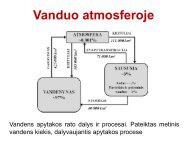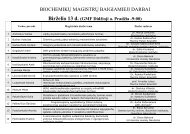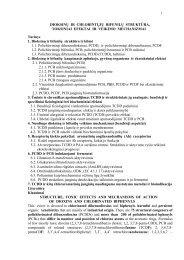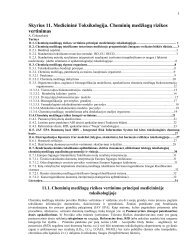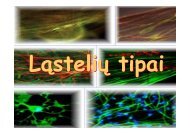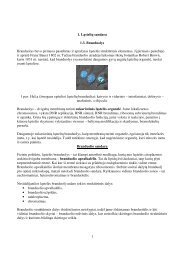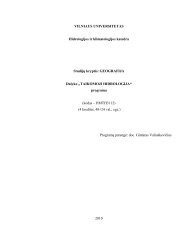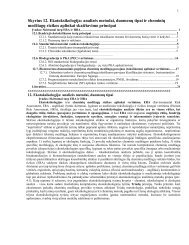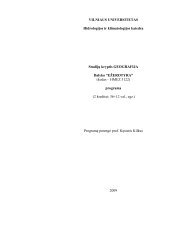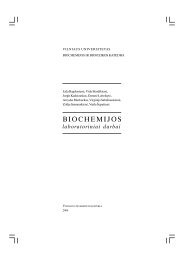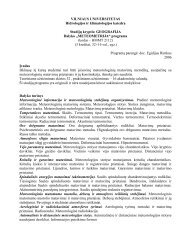Species and Their Formation - Laboratory of Visual Systems
Species and Their Formation - Laboratory of Visual Systems
Species and Their Formation - Laboratory of Visual Systems
Create successful ePaper yourself
Turn your PDF publications into a flip-book with our unique Google optimized e-Paper software.
490 CHAPTER TWENTY-FOURCOMPARATIVE METHODHypothesis: If reinforcement has occurred, sympatric species <strong>of</strong>Drosophila should be more strongly isolated prezygotically thanallopatric species that have been separated for equal amounts <strong>of</strong> time.METHODRESULTSStrongPrezygotic isolationWeakLowAssess length <strong>of</strong> time Drosophila populations have beenevolving separately by the amount <strong>of</strong> genetic distancebetween them. Compare strength <strong>of</strong> prezygoticisolation between allopatric <strong>and</strong> sympatric speciespairs.Recently diverged pairs <strong>of</strong> sympatric species havemore prezygotic isolation than allopatric species do.Genetic distanceAllopatric species pairsSympatric species pairsGenetic distance, a measure <strong>of</strong> moleculargenetic differences between the species ina pair, is an indication <strong>of</strong> the length <strong>of</strong> timethe species have been evolving separately.HighConclusion: Reinforcement has resulted in particularly rapidevolution <strong>of</strong> prezygotic isolation among recently diverged sympatricspecies <strong>of</strong> Drosophila.24.12 Prezygotic Barriers Can Evolve Rapidly Reinforcement mayoccur when individuals who mate outside their own population leavefew or no viable <strong>of</strong>fspring. In such a situation, prezygotic isolatingmechanisms can evolve extremely rapidly.as they fed on the fruits, <strong>and</strong> when they emerged from theirpupae, they used this cue to locate other hawthorn plants onwhich to mate <strong>and</strong> lay their eggs.About 150 years ago, large commercial apple orchardswere planted in the Hudson River valley. Apple trees areclosely related to hawthorns, <strong>and</strong> a few female Rhagoletis laidtheir eggs on apples, perhaps by mistake. <strong>Their</strong> larvae didnot grow as well as the larvae on hawthorn fruits, but manydid survive. These larvae recognized the odor <strong>of</strong> apples, sowhen they emerged as adults, they sought out apple trees,where they mated with other flies reared on apples.Today there are two types <strong>of</strong> Rhagoletis in the HudsonRiver valley that may be on the way to becoming distinctspecies. One feeds primarily on hawthorn fruits, the other onapples. The two incipient species are partly reproductivelyisolated because they mate primarily with individuals raisedon the same fruit <strong>and</strong> because they emerge from their pupaeat different times <strong>of</strong> the year. In addition, the apple-feedingflies have evolved so that they now grow more rapidly onapples than they originally did.Reproductive isolation does not develop at the same ratein all diverging populations. On the one h<strong>and</strong>, in somegroups, such as Darwin’s finches, there has been conspicuousmorphological evolution, but many <strong>of</strong> the 14 species stillinterbreed <strong>and</strong> produce fertile hybrid <strong>of</strong>fspring. On the otherh<strong>and</strong>, reproductive isolation may develop rapidly, as it hasbetween diverging sympatric species <strong>of</strong> Drosophila. Generally,reproductive isolation evolves more rapidly in speciesthat have rapid reproductive rates (for example, most plants,fruit flies, <strong>and</strong> sea urchins) than in species that have slowerreproductive rates (for example, birds <strong>and</strong> mammals).Many species in nature form hybrids in areas where theirranges overlap, <strong>and</strong> they may continue to do so for manyyears. Let’s examine what happens in these situations.Hybrid Zones:Incomplete Reproductive IsolationIf contact is reestablished between formerly isolated populationsbefore complete reproductive isolation has developed,members <strong>of</strong> the two populations may interbreed. Three outcomes<strong>of</strong> such interbreeding are possible:If hybrid <strong>of</strong>fspring are as successful as those resultingfrom matings within each population, hybrids mayspread through both populations <strong>and</strong> reproduce withother individuals. The gene pools would then combine,<strong>and</strong> no new species would result from the period <strong>of</strong> isolation.If hybrid <strong>of</strong>fspring are less successful, complete reproductiveisolation may evolve as reinforcement strengthensprezygotic reproductive barriers.Even if hybrid <strong>of</strong>fspring are at some disadvantage, a narrowhybrid zone may persist if, for one or more reasons,reinforcement does not happen.Hybrid zones are excellent natural laboratories for thestudy <strong>of</strong> speciation. When a hybrid zone first forms, most hybridsare <strong>of</strong>fspring <strong>of</strong> crosses between purebred individuals<strong>of</strong> the two species. However, subsequent generations includea variety <strong>of</strong> individuals with different proportions <strong>of</strong> theirgenes derived from the original two populations. Thus, hybridzones contain recombinant individuals resulting frommany generations <strong>of</strong> hybridization. Detailed genetic studiescan tell us much about why hybrid zones may be narrow <strong>and</strong>stable for long periods <strong>of</strong> time.European toads <strong>of</strong> the genus Bombina have been the subject<strong>of</strong> such studies. The fire-bellied toad (B. bombina) lives ineastern Europe. The closely related yellow-bellied toad (B.variegata) lives in western <strong>and</strong> southern Europe. The ranges<strong>of</strong> the two species meet in a narrow zone stretching 4,800 km



